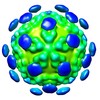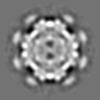+ Open data
Open data
- Basic information
Basic information
| Entry | Database: EMDB / ID: EMD-5413 | |||||||||
|---|---|---|---|---|---|---|---|---|---|---|
| Title | CryoEM map of the mature astrovirus (HAstV-1) | |||||||||
 Map data Map data | Reconstruction of mature human astrovirus HAstV-1 | |||||||||
 Sample Sample |
| |||||||||
 Keywords Keywords | T=3 virus | |||||||||
| Biological species |  Human astrovirus Human astrovirus | |||||||||
| Method | single particle reconstruction / cryo EM / Resolution: 25.0 Å | |||||||||
 Authors Authors | Dryden KA / Tihova M / Nowotny N / Matsui SM / Mendez E / Yeager M | |||||||||
 Citation Citation |  Journal: J Mol Biol / Year: 2012 Journal: J Mol Biol / Year: 2012Title: Immature and mature human astrovirus: structure, conformational changes, and similarities to hepatitis E virus. Authors: Kelly A Dryden / Mariana Tihova / Norbert Nowotny / Suzanne M Matsui / Ernesto Mendez / Mark Yeager /   Abstract: Human astroviruses (HAstVs) are a major cause of gastroenteritis. HAstV assembles from the structural protein VP90 and undergoes a cascade of proteolytic cleavages. Cleavage to VP70 is required for ...Human astroviruses (HAstVs) are a major cause of gastroenteritis. HAstV assembles from the structural protein VP90 and undergoes a cascade of proteolytic cleavages. Cleavage to VP70 is required for release of immature particles from cells, and subsequent cleavage by trypsin confers infectivity. We used electron cryomicroscopy and icosahedral image analysis to determine the first experimentally derived, three-dimensional structures of an immature VP70 virion and a fully proteolyzed, infectious virion. Both particles display T=3 icosahedral symmetry and nearly identical solid capsid shells with diameters of ~350Å. Globular spikes emanate from the capsid surface, yielding an overall diameter of ~440Å. While the immature particles display 90 dimeric spikes, the mature capsid only displays 30 spikes, located on the icosahedral 2-fold axes. Loss of the 60 peripentonal spikes likely plays an important role in viral infectivity. In addition, immature HAstV bears a striking resemblance to the structure of hepatitis E virus (HEV)-like particles, as previously predicted from structural similarity of the crystal structure of the astrovirus spike domain with the HEV P-domain [Dong, J., Dong, L., Méndez, E. & Tao, Y. (2011). Crystal structure of the human astrovirus capsid spike. Proc. Natl. Acad. Sci. USA108, 12681-12686]. Similarities between their capsid shells and dimeric spikes and between the sequences of their capsid proteins suggest that these viral families are phylogenetically related and may share common assembly and activation mechanisms. | |||||||||
| History |
|
- Structure visualization
Structure visualization
| Movie |
 Movie viewer Movie viewer |
|---|---|
| Structure viewer | EM map:  SurfView SurfView Molmil Molmil Jmol/JSmol Jmol/JSmol |
| Supplemental images |
- Downloads & links
Downloads & links
-EMDB archive
| Map data |  emd_5413.map.gz emd_5413.map.gz | 22.3 MB |  EMDB map data format EMDB map data format | |
|---|---|---|---|---|
| Header (meta data) |  emd-5413-v30.xml emd-5413-v30.xml emd-5413.xml emd-5413.xml | 8.4 KB 8.4 KB | Display Display |  EMDB header EMDB header |
| Images |  emd_5413_1.jpg emd_5413_1.jpg | 58.2 KB | ||
| Archive directory |  http://ftp.pdbj.org/pub/emdb/structures/EMD-5413 http://ftp.pdbj.org/pub/emdb/structures/EMD-5413 ftp://ftp.pdbj.org/pub/emdb/structures/EMD-5413 ftp://ftp.pdbj.org/pub/emdb/structures/EMD-5413 | HTTPS FTP |
-Related structure data
- Links
Links
| EMDB pages |  EMDB (EBI/PDBe) / EMDB (EBI/PDBe) /  EMDataResource EMDataResource |
|---|
- Map
Map
| File |  Download / File: emd_5413.map.gz / Format: CCP4 / Size: 58.9 MB / Type: IMAGE STORED AS FLOATING POINT NUMBER (4 BYTES) Download / File: emd_5413.map.gz / Format: CCP4 / Size: 58.9 MB / Type: IMAGE STORED AS FLOATING POINT NUMBER (4 BYTES) | ||||||||||||||||||||||||||||||||||||||||||||||||||||||||||||||||||||
|---|---|---|---|---|---|---|---|---|---|---|---|---|---|---|---|---|---|---|---|---|---|---|---|---|---|---|---|---|---|---|---|---|---|---|---|---|---|---|---|---|---|---|---|---|---|---|---|---|---|---|---|---|---|---|---|---|---|---|---|---|---|---|---|---|---|---|---|---|---|
| Annotation | Reconstruction of mature human astrovirus HAstV-1 | ||||||||||||||||||||||||||||||||||||||||||||||||||||||||||||||||||||
| Projections & slices | Image control
Images are generated by Spider. | ||||||||||||||||||||||||||||||||||||||||||||||||||||||||||||||||||||
| Voxel size | X=Y=Z: 2 Å | ||||||||||||||||||||||||||||||||||||||||||||||||||||||||||||||||||||
| Density |
| ||||||||||||||||||||||||||||||||||||||||||||||||||||||||||||||||||||
| Symmetry | Space group: 1 | ||||||||||||||||||||||||||||||||||||||||||||||||||||||||||||||||||||
| Details | EMDB XML:
CCP4 map header:
| ||||||||||||||||||||||||||||||||||||||||||||||||||||||||||||||||||||
-Supplemental data
- Sample components
Sample components
-Entire : mature human astrovirus HAstV-1
| Entire | Name: mature human astrovirus HAstV-1 |
|---|---|
| Components |
|
-Supramolecule #1000: mature human astrovirus HAstV-1
| Supramolecule | Name: mature human astrovirus HAstV-1 / type: sample / ID: 1000 / Number unique components: 1 |
|---|
-Supramolecule #1: Human astrovirus
| Supramolecule | Name: Human astrovirus / type: virus / ID: 1 / NCBI-ID: 12702 / Sci species name: Human astrovirus / Database: NCBI / Virus type: VIRION / Virus isolate: STRAIN / Virus enveloped: No / Virus empty: No |
|---|---|
| Host (natural) | Organism:  Homo sapiens (human) / synonym: VERTEBRATES Homo sapiens (human) / synonym: VERTEBRATES |
| Virus shell | Shell ID: 1 / Diameter: 440 Å / T number (triangulation number): 3 |
-Experimental details
-Structure determination
| Method | cryo EM |
|---|---|
 Processing Processing | single particle reconstruction |
| Aggregation state | particle |
- Sample preparation
Sample preparation
| Buffer | Details: 50mM Tris-HCl, pH 8, 100mM NaCl, 10mM MgCl2, 10mM CaCl2 |
|---|---|
| Grid | Details: holey carbon, glow discharged with amylamine |
| Vitrification | Cryogen name: ETHANE / Instrument: HOMEMADE PLUNGER / Method: watch drop spread on filter paper before plunging |
- Electron microscopy
Electron microscopy
| Microscope | FEI/PHILIPS CM120T |
|---|---|
| Date | Sep 22, 1997 |
| Image recording | Category: FILM / Film or detector model: KODAK SO-163 FILM / Digitization - Scanner: ZEISS SCAI / Digitization - Sampling interval: 7 µm / Number real images: 6 |
| Electron beam | Acceleration voltage: 120 kV / Electron source: LAB6 |
| Electron optics | Illumination mode: FLOOD BEAM / Imaging mode: BRIGHT FIELD / Nominal defocus max: 1.85 µm / Nominal defocus min: 1.45 µm / Nominal magnification: 35000 |
| Sample stage | Specimen holder model: GATAN LIQUID NITROGEN |
- Image processing
Image processing
| Details | Particles were selected with X3D, and processed with Auto3dem. |
|---|---|
| Final reconstruction | Algorithm: OTHER / Resolution.type: BY AUTHOR / Resolution: 25.0 Å / Resolution method: FSC 0.5 CUT-OFF / Software - Name: Auto3dem / Number images used: 397 |
 Movie
Movie Controller
Controller



 UCSF Chimera
UCSF Chimera






 Z (Sec.)
Z (Sec.) Y (Row.)
Y (Row.) X (Col.)
X (Col.)





















